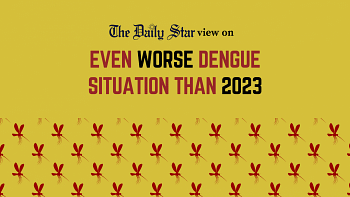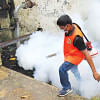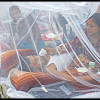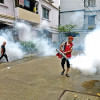Want to tackle the urban heatwave-dengue-flooding saga? Restore urban ecosystems

Residents of Dhaka are now preparing to face the dengue outbreak and flooding, with the memory of their recent suffering from scorching heat still fresh. The heatwave-dengue-flooding saga repeats yearly, and we attempt to address these issues individually and temporarily. We discuss, for instance, the importance of tree-planting during heatwaves, or highlight the importance of bush and drainage clearing during dengue outbreaks, and call for restoring drains, canals, and waterbodies during floods. However, with the annual occurrence of this polycrisis, people's suffering increases exponentially. We must, therefore, look into them holistically, determine the underlying causes, and seek sustainable solutions.
The good news is that we already know one of the root causes: the destruction of urban nature. Urban nature encompasses plants, animals, soils, water bodies, and their interactions. And it is no secret that Dhaka has already lost about 56 percent of its green spaces and 36 percent of its water bodies over the past few decades, mainly due to unplanned urbanisation. Losses of green and blue spaces meet with the loss and, to some extent, spatial redistribution of biodiversity. And when habitat and biodiversity are lost, the urban ecological balance collapses, leading to complex and multidimensional socio-ecological problems, including those that we currently face.
One could argue that increasing heatwaves, floods or pathogenic outbreaks are global phenomena attributed to climate change, and the state of Dhaka's nature contributes little to those phenomena. While that's partly true, it is crucial to understand that the localised loss of nature aggravates the problem locally and limits people's ability to adapt. For instance, although tree cover loss in Dhaka alone may have little impact on atmospheric temperature or rainfall, such a loss would undoubtedly increase people's suffering during heatwaves by manifolds. During the last heatwave, we witnessed a marked difference in heat-related suffering between areas with and without tree cover in Dhaka. Likewise, the loss of water bodies, which serve as storage and drainage conduits for rainwater, increases floods in Dhaka. Even an hour-long rain generates flooding and waterlogging in many areas. Above all, the loss of mosquito habitats, mosquito predators or the disruption of ecological networks that supposedly regulate mosquito density beyond people's residences could substantially increase the prevalence of dengue outbreaks.
Therefore, increasing tree cover, recovering wetlands, and regulating mosquito density are vital for tackling Dhaka's polycrisis of heatwave, dengue and flooding. However, trees, wetlands, and mosquito density are interlinked components of an ecosystem. And it is not easy to do these in isolation. The wetland recovery efforts can only be effective and sustainable when trees are planted on the bank of water bodies and a protective riparian buffer is maintained. The effectiveness of mosquito control efforts also depends on maintaining mosquito predators such as frogs and entomophagous animals, underscoring the need for conserving urban biodiversity. Holistic thinking and restoring nature are thus germane for addressing the contemporary socio-ecological problems in Dhaka.
Still, we plan to carry out these necessary actions separately and instantly. These efforts are also transient. We forget them when the season ends. Our city and urban planning rarely highlights the need to conserve urban biodiversity. Most disturbingly, we continue to see Dhaka's nature degrading unabated. Media reports of tree-cutting or filling of water bodies now appear so regularly that they hardly make any ripple. All these happen amid the firm commitments from the highest level of the government and city corporation authorities towards nature conservation and building a climate-resilient, green, and prosperous Dhaka.
It is still unclear what the reasons are for the apparent contradiction between the government's commitment to conserving nature versus actions, such as tree-felling and water body filling for development. However, one explanation is that the relevant authorities likely lack a fundamental understanding of nature or how to balance conservation and development. This may not be surprising because our city and urban planning authorities, such as city corporations and RAJUK, mainly comprise professionals (e.g., planners, architects, and engineers) and administrators trained to think of engineering solutions. Engineering-focused training can be insufficient when dealing with issues, such as restoring urban nature and ecosystems, that require nature-based solutions. Although incorporating specialist advice can overcome the problem, authorities rarely consider tree planting and ecosystem restoration as specialised disciplines requiring specialised skills and advice. So, they rely on common sense or traditional knowledge to plan tree-planting, wetland restoration or mosquito control.
As a result, we see elementary mistakes during planning and implementing the city's nature improvement efforts. A recent report in Prothom Alo emphasised expert concern over the choice of planting species in Dhaka. Another opinion published in The Daily Star expressed doubts about the timing of tree-planting. In fact, when we choose species, we rarely seek specialist advice or consider whether the species are suitable for the soil condition, whether it will be aesthetically pleasant, provide shade, support other animals such as birds and insects, whether it will be hazardous for urban residents or whether it will reflect Bangladeshi character. Unsurprisingly, we find the wrong species in the wrong place, like jackfruit and banyan trees on road dividers. Likewise, our wetland recovery efforts rarely consider maintaining a protective vegetation belt around the bank of water bodies, though tree-planting on the bank of water bodies could ensure bank stability and create biodiversity habitats and riparian ecosystems. Our mosquito control efforts also focus on spraying chemicals to kill mosquitos or their larvae without considering the importance of maintaining mosquito predators. Nevertheless, most issues, including species choice, planting time, ecological restoration or biodiversity conservation are the subject matters of ecology. And incorporating ecological insights can improve the effectiveness and sustainability of preserving and restoring Dhaka's nature.
Most of today's urban problems are rooted in destroying the urban ecosystem. Therefore, we must halt the ongoing destruction of urban nature and, at the same time, restore the degraded urban ecosystems. To that end, we should assemble a multidisciplinary team including urban planners, ecologists, landscape architects, environmental scientists, and engineers. We should draw from ecology and envision ecosystem restoration beyond tree-planting or wetland protection. This way, we can demonstrate our initial seriousness towards adapting to the heatwave-dengue -flooding saga effectively and build a climate-resilient and green Dhaka where we can live and prosper sustainably.
Dr Shekhar R Biswas is a professor of ecology at East China Normal University in Shanghai.
Views expressed in this article are the author's own.
Follow The Daily Star Opinion on Facebook for the latest opinions, commentaries and analyses by experts and professionals. To contribute your article or letter to The Daily Star Opinion, see our guidelines for submission.

 For all latest news, follow The Daily Star's Google News channel.
For all latest news, follow The Daily Star's Google News channel. 











Comments